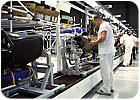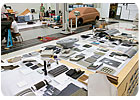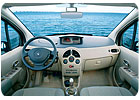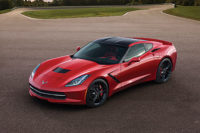Believe it or not, cup holders were unheard of in automobiles 25 years ago. But not anymore. Americans are spending more and more time inside their cars, and the market is responding accordingly. Today, interiors are ground zero for automakers and suppliers.

Believe it or not, cup holders were unheard of in automobiles 25 years ago. Instead, savvy entrepreneurs marketed a variety of gizmos that clipped onto dashboards, floor consoles, glove boxes and steering wheels. Today, cup holders are a ubiquitous feature found in every vehicle on the road, from sports cars to farm tractors. Some cup holders are even equipped with cooling and heating functions. In fact, most automobiles now contain more cup holders than ashtrays.
That evolution is due to changing lifestyles and the simple fact that motorists are spending more time than ever behind the wheel. The average number of vehicle miles traveled in the United States has risen 74 percent since 1982. According to researchers at the Texas Transportation Institute (College Station, TX), much of that rampant growth is due to increasing road congestion and gridlock.
For instance, the number of urban areas with more than 20 hours of annual delay per peak traveler skyrocketed from only five in 1982 to 51 in 2003. Today, the average weekday commute to and from work in Chicago is 90 minutes each way. While traffic delays are a fact of life in large cities, the gridlock trend is starting to spill over to midsize metropolitan areas, such as Charlotte, NC; Orlando, FL; Sacramento, CA; and Tucson, AZ.
Unfortunately, experts predict things won’t get any better in the future. During the next 20 years, gridlock is expected to increase by more than 50 percent.
As a result, seats, instrument panels, headliners, storage bins, steering wheels, door panels and bolsters, floor consoles, trim and other interior features are growing increasingly important to consumers. In fact, the interior is the only part of a vehicle that drivers have an intimate connection with.
People are demanding more interior features that provide comfort, convenience, safety and security. As a result, “interiors have become a real battleground in the auto industry,” says David Cole, chairman of the Center for Automotive Research (CAR, Ann Arbor, MI). “The overall execution of interiors is way up. Everyone wants to see interiors that are richer, but price and performance pressures are enormous.”
“Consumers are putting more emphasis on creature comforts and how they interact with them,” adds Neal Oddes, director of product research and analysis at J.D. Power and Associates (Westlake Village, CA). “They want a pleasant and positive experience while driving.”
Growing electronic content and recycling initiatives are having a big impact on the way that interior components are designed and assembled. However, engineers at automakers and suppliers are faced with a catch-22: Deliver more comfort, entertainment and safety features while lowering production cost, boosting quality, reducing warranty claims, improving manufacturability and addressing environmental concerns. That calls for new materials, new production methods and new ways of looking at interiors.

Interior Motives
General Motors Corp. (GM, Detroit) and Toyota Motor Corp. (Nagoya, Japan) are engaged in a fierce battle for No. 1 in the marketplace. Part of the war is being fought inside vehicles. Both automakers have been focusing more attention on interiors.
“Interior systems are emerging as the focal point of differentiation for automakers in a highly competitive marketplace,” says Amit Goel, a research analyst at Frost & Sullivan Inc. (San Antonio). “Customers are demanding increasing customization of interior systems, and in turn, are compelling automakers to constantly upgrade and add sophisticated features with emphasis on sharp styling, ergonomic design, convenience and recyclable materials. Automakers are pushing hard to offer customized features and differentiate vehicles not only from their competitors, but also from other vehicles in their own lines.”
“Once inside, it’s the interior that seals the deal [with consumers],” adds Bob Lutz, GM’s vice chairman of global product development. “The interior must reflect far more value than the actual price of the car.
“If you’re doing a $20,000 car, you have to have what looks like a $30,000 interior,” claims Lutz. “That calls for clever use of materials. You can also do clever things with plastic parts that have to be molded anyway, but molded in such a way that they can hold things, like map pockets in plastic-molded door trim panels.”
According to Lutz, “power outlets [to plug in portable electronic devices] are the new cup holders.” He also says that “clever little storage areas” and secondary glove compartments “are becoming the rage.”
When the 2008 Cadillac CTS was unveiled at the North American International Auto Show in Detroit last month, its interior created a tremendous buzz in the industry. The vehicle features front seats that are several inches thinner than normal, which provides more space and extra leg room. “The U.S. fashion of seatbacks that are 6 or 7 inches thick simply wastes interior space,” explains Lutz.
Johnson Controls Inc. (Milwaukee), a leading supplier of interior components, also unveiled a new ultra-thin front seat at the Detroit show. It features a thin centerline cross-section that is made from tubular steel. The seat delivers additional knee room for backseat occupants, but it provides the same level of comfort, convenience and safety as traditional front-row seats.
“Today’s consumers are ready for significant innovation in the design, functionality and aesthetic appeal of vehicle seats, while automakers have a strong interest in creating more spacious interiors,” says Jeff Williams, vice president and general manager of automotive experience at Johnson Controls. “Consumers expect comfort no matter where they’re sitting in a vehicle.”
The Thin Seat is targeted for model-year 2010 production vehicles, but Williams claims that it can be produced using currently available materials, assembly processes and components.
Automakers around the world are focusing on interior craftsmanship as they seek appearance goals that set their products apart from the competition. “Regardless of how well a car is engineered, if the fit and finish don’t match or any of the components look inexpensive, most consumers believe that the entire vehicle is lacking in quality,” claims Douglas DelGrosso, president and chief operating officer of Lear Corp. (Southfield, MI), another Tier One supplier of interior components.
“Consumers form their opinion on a vehicle based on the look and feel of its components and the level of perceived quality,” says DelGrosso. “Increased consumer attention to ‘look and feel’ has spurred heightened automaker focus on interior quality and craftsmanship.”
According to the Warwick Manufacturing Group (Coventry, England), the quality of a vehicle’s craftsmanship is more important to owners than its drive-or even reliability-when influencing brand loyalty in the highly competitive premium car segment. Repeat purchasing is directly linked to consumer satisfaction and craftsmanship.
“Craftsmanship is about quality of design execution that gives the product the appearance of being well made and well functioning at its very early interaction with the customer,” explains DelGrosso. “Perception is not always conscious, but perception can be influenced.”
When it comes to interior design, Audi AG (Ingolstadt, Germany) has served as the benchmark of the auto industry for many years. But, other automakers are slowly starting to catch up. They’re paying more attention to surface textures and the critical interface between dashboards, doors, floor consoles and other interior components.
“Over the past several years, North America’s domestic automakers have expressed renewed interest in interior trim styling and the use of quality materials across their line-up,” says Don Montroy, senior market analyst at CSM Worldwide (Northville, MI). “There is a big push to have interior trim materials, sound quality, and overall fit and finish equal to that of European and Japanese luxury models.”
In addition to seating, Montroy says instrument panels are transforming and redefining interior design. The Big Three lag behind their Asian and European competitors, because they use more hard plastic injection-molded instrument panels, but that’s starting to change. Suppliers are turning to new molding techniques that create softer plastic.
By taking design cues from consumer electronic products, such as cell phones, computers, iPods, MP3 players and wristwatches, instrument panels are also becoming much more stylish. For instance, the 2007 Ford Mustang features a color-configurable dashboard. It allows consumers to mix and match lighting at the touch of a button to create more than 125 color backgrounds to suit their personalities, moods, outfits or whims. The system consists of blue, green and red light-emitting diodes that are projected through light pipe fittings on the sides of the speedometer and tachometer.
At the recent Detroit auto show, Ford unveiled a concept vehicle that features a futuristic interior. The Airstream uses a floating instrument panel with flush-mounted, touch-sensitive controls. A multifunction, single-gauge display provides the driver with all primary information.
Another concept vehicle unveiled at the show also reveals what future instrument panels may look like. The Chrysler Nassau features new technologies in data display, personal control interface and home theater-inspired entertainment. Gear selection is accomplished via a pod control mounted on the instrument panel, while the steering wheel incorporates auxiliary paddle shifters. Within the housing of the instrument panel is a three-layer screen, which allows simultaneous display of navigation, passenger entertainment and vehicle functions.

Plastic Challenges
The plastic content in vehicles has increased dramatically in recent years. According to the American Plastics Council (Arlington, VA), the average car contains 250 pounds of plastic. Interior parts and components account for a significant chunk of that weight.
Plastic has revolutionized automotive interiors. It’s an ideal material for creating comfortable, durable and aesthetically pleasing components, while reducing noise, vibration and harshness (NVH) levels.
But, plastic poses some disadvantages. For instance, outgassing from polymer components can create problems in vehicle interiors, such as releasing unpleasant odors that can bother some people. Outgassing can also cause fogging of instrument clusters and leave a film on the interior of the windshield.
“Many plastics [used for interior components] are made with harmful chemical additives, such as phthalates in polyvinyl chloride and brominated flame retardants,” claims Claudette Juska, a former mechanical engineer at Ford who now works at the Ecology Center (Ann Arbor, MI) and recently authored a report on the use of plastics in the auto industry. “These additives off-gas and leach from plastic parts, contaminating the air and dust inside vehicles, putting drivers and passengers at risk.”
However, despite those concerns, the design flexibility of plastic allows manufacturers to create single-piece, lightweight components. For example, instrument panels were traditionally made from several separate components that needed to be painted and were all held together by a steel support beam that lay behind the panel. Today, new plastics technology allows engineers to eliminate the support beam, which reduces both the cost and weight of instrument panels, and simplifies assembly.
Wholly integrated single-piece units can be manufactured from all-urethane and all-polypropylene resins. This results in a seamless instrument panel that greatly reduces NVH levels. However, buzzing, squeaks and rattles (BSR) remain one of the auto industry’s biggest warranty issues.
That’s because instrument panels and other interior components can experience surface temperatures ranging from subzero to 221 F. These large variations in temperature lead to expansions and contractions, which can change the physical properties of thermoplastics.
In new instrument panel designs, thermoplastic resin characteristics are very important, says Jane Horal, automotive interior segment manager at Basell North America Inc. (Elkton, MD), a leading supplier of polypropylene and polyolefin.
“These characteristics enable the instrument panel system to perform [with air bags] at both cold and hot deployment,” notes Horal.
“The requirements for each OEM instrument panel are typically specific to each platform,” Horal points out. “They have become more stringent in recent years as larger instrument panels with more significant horizontal surfaces have placed ever-increasing demands on material suppliers. Instrument panel designs can be, depending on their design, hard (no padding over the substrate) molded-in color, painted or soft (padded skin over the substrate).”
Many automakers are specifying soft-touch thermoplastics, which impart a luxurious feel and an aesthetically appealing appearance to many interior components. According to CSM’s Montroy, Ford, GM and DaimlerChrysler use more hard plastic, injection-molded instrument panels than Honda, Nissan and Toyota.
“Cost pressures forced them to use less expensive skin materials, such as polyvinyl chloride, for soft-feel instrument panels,” he points out. “Environmental concerns drove Honda and Toyota to pursue alternative skins. Honda, for the most part, uses thermo polyolefin skins, while Toyota uses thermo polyurethane skin material.” However, Montroy expects the Big Three to begin using greater quantities of the more expensive, environmentally friendly skin materials than they used in the past.
Traditionally, GM instrument panels have been built using painted polycarbonate and acrylonitrile butadiene styrene (PC/ABS) parts of vinyl skin-and-foam construction. But, the automaker recently started using thermoplastic polyofefin for its Chevrolet Colorado and GMC Canyon pickup trucks. The instrument panel is molded by Intier Automotive Inc. (Newmarket, ON).
“You can really see the grain on the surface, because you’re not filling it full of paint,” notes Gary Kulhanek, senior account manager at Solvay Engineered Polymers (Auburn Hills, MI), which supplies the resin for the application. “The result is a more leatherlike appearance and a look that has been described as ‘frugally elegant’ in an entry-level vehicle. For all its structural stiffness and scratch resistance, this instrument panel has a softer feel than one molded in PC/ABS.”
New Technology
Whether interior components are hard or soft, eliminating squeaks and rattles remains one of the biggest challenges facing automakers and suppliers. “Softer plastics create tougher fastening situations,” says Dave Nebl, engineering manager at ITW Shakeproof Assembly Components (Broadview, IL). That situation is compounded by an ongoing trend toward using thinner fastening bosses or wall thickness to save weight and money.
“We have had tremendous success addressing these challenges with our new BosScrew, which was designed specifically for plastic tapping applications, such as instrument panels and door trim panels,” explains Nebl. The threaded fastener has an innovative design that keeps it from backing out when inserted in plastic automotive parts.
“With BosScrew’s unique thread, the cold-flow of plastic creates an anti-loosening interlock,” claims Nebl. “The result is that plastic parts in difficult-to-reach places [such as instrument panels] stay attached firmly to each other, eliminating rattling and reducing warranty costs as a result.”
Clamps and metal inserts can be eliminated, because the fastener can go directly into plastic components. “We received an order from GM for 60 million fasteners to attach the door panels on 2007 full-size sport utility vehicles and pickup trucks,” says Nebl. “The screw we replaced was loosening and backing out.”
Adhesives are a viable alternative to fasteners for some interior assembly applications, depending upon the dynamics the joint will be exposed to and any concerns for long-term function and serviceability. According to Rusty Mansel, marketing manager for automotive interiors and exteriors at Henkel Corp. (Madison Heights, MI), products specifically aimed at BSR can be designed in with components. These products include light-curing acrylic gasket materials and two-part foamed urethane materials.
“Both of these products [can be integrated with] the part and eliminate BSR issues, along with preventing moisture and dust from penetrating the vehicle and its components,” says Mansel.
Automakers are increasingly using low-cost, recyclable plastics, such as polyethylene and prolypropylene, for interior components. But, these materials are also difficult to bond.
Traditionally, instrument panels, door panels and other parts were produced from several different components that were attached with different methods, such as pressure-sensitive adhesive, snap-fits or Velcro. However, interior suppliers have recently developed new manufacturing techniques, such as a two-shot molding process, and new materials, such as sprayable polyurethane, to streamline production and improve flexibility.
Two-shot technology is an injection-molding process that first shoots a material on a substrate, then moves or rotates to shoot a second color or material-all in one mold cycle. “This produces a part that can be a combination of two different colors, materials or textures,” explains Lear’s DelGrosso. With one molding cycle and reduction of assembly time, there can be considerable cost savings, as well as increased design flexibility and craftsmanship.
Spray PUR is the process of spraying polyurethane over a tool for a soft skin automotive part. The urethane is typically two components: icocyanate plus polyol, which react in the tool or mixing head to form one polyurethane skin. “The benefits are improved craftsmanship, with superior grain definition and low gloss, as well as a softer touch and multitone options,” says DelGrosso. “The finish also offers excellent performance, durability and scratch resistance.”
Lear recently unveiled injection-molding technology that enables it to cost-effectively manufacture large interior plastic panels with multiple materials in one machine. The FreeForm system is being used to produce door bolsters for the 2007 Dodge Caliber. “It provides a well-crafted interface between colors and textures, whereas other methods require painting, secondary operations or multiple components,” explains DelGrosso.
The FreeForm process uses a machine from Husky Injection Molding Systems Ltd. (Bolton, ON) that employs two identical cores which rotate a substrate to an adjacent new cavity where a thermoplastic elastomer skin is then overmolded. The manufacturing process molds large components in 60 seconds, eliminating secondary parts, presses, labor and equipment.
“In addition to delivering a complete part with less downstream assembly and lower operating costs, a major benefit is enhanced quality as a result of the machine’s ability to produce molded-in gaps to produce crisp lines and improved fit and finish,” says DelGrosso. “Another key advantage is flexibility. The equipment is designed so that our engineers are not limited to a two-shot process. It allows us to mold-in any surface finish a customer desires, including multiple colors, textures and grains.” The process also is safer and more environmentally friendly than other methods, such as soft-touch paints.

A Green Future?
Automakers and suppliers are currently scrambling to provide “green” interiors. “There is emphasis [on being green] at all levels of the industry,” says CAR’s Cole. “For the interior, it means reducing the variations in polymer composition and emphasis on thermoplastics vs. thermoset materials that are difficult to recycle.”
Engineers are keeping a close eye on Europe, which has enacted an ambitious end-of-life vehicle recycling program. The European directive intends to cut down on automotive landfill waste, while increasing parts reuse. Effective Jan. 1, 2006, end-of-life vehicles have to be 85 percent recyclable by mass. That threshold will rise to 95 percent in 2015.
According to the Ecology Center, U.S. automakers have stepped up their efforts to use bio-based materials that reduce petroleum use, life-cycle carbon emissions and vehicle weight. Unlike plastic made from petroleum, bioplastics are made from natural resins found in bamboo, coconut, corn, kenaf, sugar cane and other plants.
Toyota has led the way by pioneering the development of Eco-Plastic, which is derived from raw materials such as corn and sugar cane. It has set up a pilot plant in Japan to develop mass-production technologies. The automaker plans to use 20 million tons of the material by 2020. Toyota has also set a goal of having 15 percent of its plastic parts made from renewable or recycled materials by 2010. The company has already begun using kenaf fibers as reinforcement in some interior components.
DaimlerChrysler and Ford also received passing grades in a recent report conducted by the Ecology Center. DaimlerChrysler has been experimenting with using abaca and flax fibers, while Ford engineers have developed a soy-based foam that will be used as a bio-fabric for seats.
Mazda Motor Corp. (Hiroshima, Japan) has also developed a bioplastic that can be used for interior components. It is made from 88 percent corn and 12 percent petroleum.
“In contrast to current petroleum-based polypropylene plastics, the new bioplastic has comparatively higher rigidity, resulting in thinner molds and fewer materials used,” says Seita Kanai, senior managing executive officer in charge of R&D. “These attributes hold great promise for better productivity in the mass production of vehicle parts, since parts manufacture frequently involves injection-molding equipment.”

